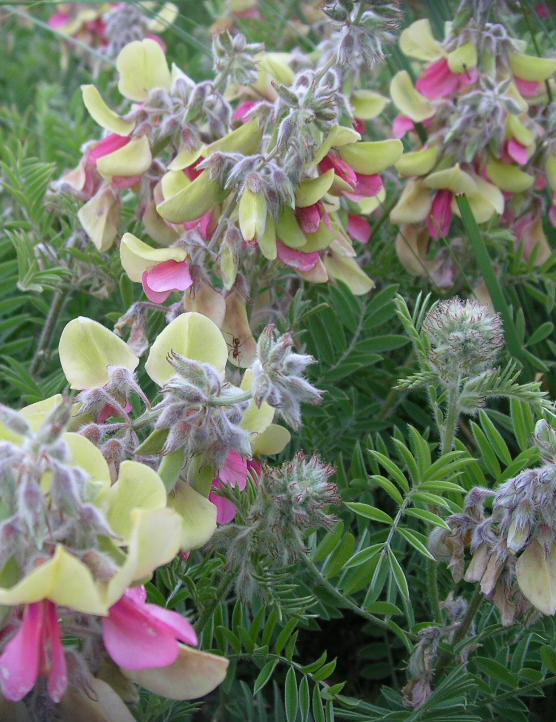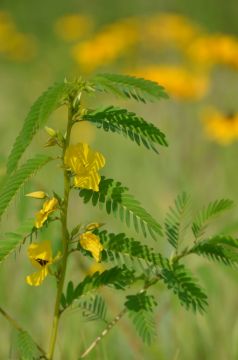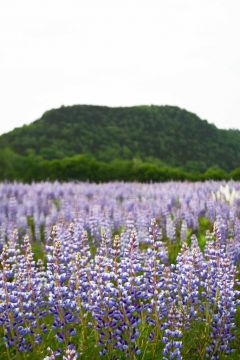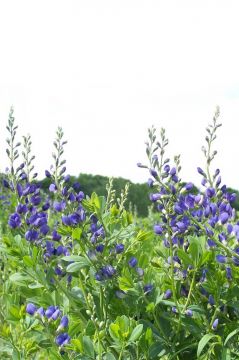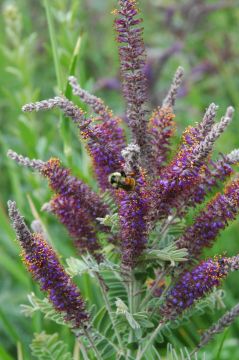This legume's seeds form among attractive feather-like, greenish-gray leaves in late summer. Distinctive hairy, flat 2"-long pods cover the plant, making identification easy. Choose a dry, moderately sunny spot wisely because, once established, Goat's Rue does not divide and does not like to be moved. This perennial has a deep taproot that eventually branches into fibrous roots.
The roots of Goats Rue were pounded by indigenous people of southeastern North America to bring fish to the surface. All parts of the plant are mildly toxic to humans and other animals.
Other common names include Catgut, Devil's Shoestrings, Hoary Pea, Wild Sweetpea, North American Turkey Pea, and Virginia Tephrosia.
Species of genus Tephrosia are legumes. Most legume species harbor beneficial bacteria called rhizobia on their roots. Genus-specific strains of this bacterium called inoculum can aid in the fixation of atmospheric nitrogen and improve long-term health of native plant communities. Inoculum is naturally-occurring in most soils and additional amendment is usually not needed. However, in low fertility soils it may be necessary. Genus-specific strains are available at prairiemoon.com/inoculum
| Live Plant Shipping Table | |||
| Spring | Fall | Age/Size | |
| Potted 3-Packs | May/June | August/September | 2.5" wide x 3.5" deep pots |
| Potted Trays of 50 | May | August | 2" wide x 5" deep plugs |
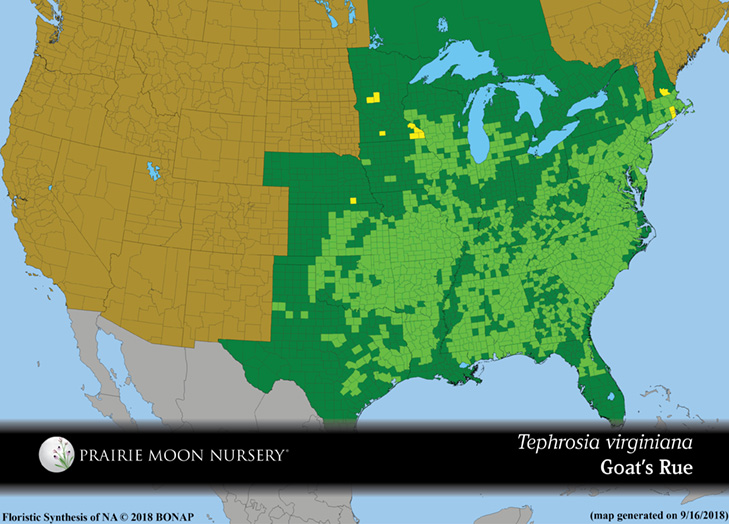
Map Key
This map shows the native and introduced (adventive) range of this species. Given appropriate habitat and climate, native plants can be grown outside their range.
1 Question asked on Tephrosia virginiana
Seed
Growing your own plants from seed is the most economical way to add natives to your home. Before you get started, one of the most important things to know about the seeds of wild plants is that many have built-in dormancy mechanisms that prevent the seed from germinating. In nature, this prevents a population of plants from germinating all at once, before killing frosts, or in times of drought. To propagate native plants, a gardener must break this dormancy before seed will grow.
Each species is different, so be sure to check the GERMINATION CODE listed on the website, in the catalog, or on your seed packet. Then, follow the GERMINATION INSTRUCTIONS prior to planting. Some species don't need any pre-treatment to germinate, but some species have dormancy mechanisms that must be broken before the seed will germinate. Some dormancy can be broken in a few minutes, but some species take months or even years.
Seed dormancy can be broken artificially by prolonged refrigeration of damp seed in the process of cold/moist STRATIFICATION. A less complicated approach is to let nature handle the stratifying through a dormant seeding, sowing seeds on the surface of a weed-free site in late fall or winter. Tucked safely beneath the snow, seeds will be conditioned by weathering to make germination possible in subsequent growing seasons.
To learn more, read our BLOG: How to Germinate Native Seeds
Dormant Bare Root Plants
We dig plants when they are dormant from our outdoor beds and ship them April-May and October. Some species go dormant in the summer and we can ship them July/August. We are among the few still employing this production method, which is labor intensive but plant-friendly. They arrive to you dormant, with little to no top-growth (bare-root), packed in peat moss. They should be planted as soon as possible. Unlike greenhouse-grown plants, bare-root plants can be planted during cold weather or anytime the soil is not frozen. A root photo is included with each species to illustrate the optimal depth and orientation. Planting instructions/care are also included with each order.
Download: Installing Your Bare-Root Plants
Potted Plants
3-packs and trays of 32, 38, or 50 plants leave our Midwest greenhouses based on species readiness (being well-rooted for transit) and order date; Spring shipping is typically early May through June, and Fall shipping is mid-August through September. Potted 3-packs and trays of 38 plugs are started from seed in the winter so are typically 3-4 months old when they ship. Trays of 32/50 plugs are usually overwintered so are 1 year old. Plant tray cells are approximately 2” wide x 5” deep in the trays of 38 and 50, and 2.5" wide x 3.5" deep in the 3-packs and trays of 32; ideal for deep-rooted natives. Full-color tags and planting & care instructions are included with each order.
Download: Planting and Care of Potted Plants
Shipping & Handling Charges
SEED$100.00 and under: $5.00over $100.00: 5% of the total seed cost
*MN State Sales Tax of 7.375% is applied for orders shipping to Minnesota only. Shipping & Handling Charges are also subject to the sales tax.
Shipping Season
SEED, TOOLS and BOOKS are sent year-round. Most orders ship within a day or two upon receipt.
*We are unable to ship PLANTS outside the contiguous US or to California due to regulations.
Delivery
We ship using USPS, UPS and Spee Dee.
FOR MORE DETAILED SHIPPING INFORMATION, INCLUDING CANADA SHIPPING RATES (SEED ONLY), PLEASE SEE 'SHIPPING' AT THE FOOTER OF THIS WEBSITE.

